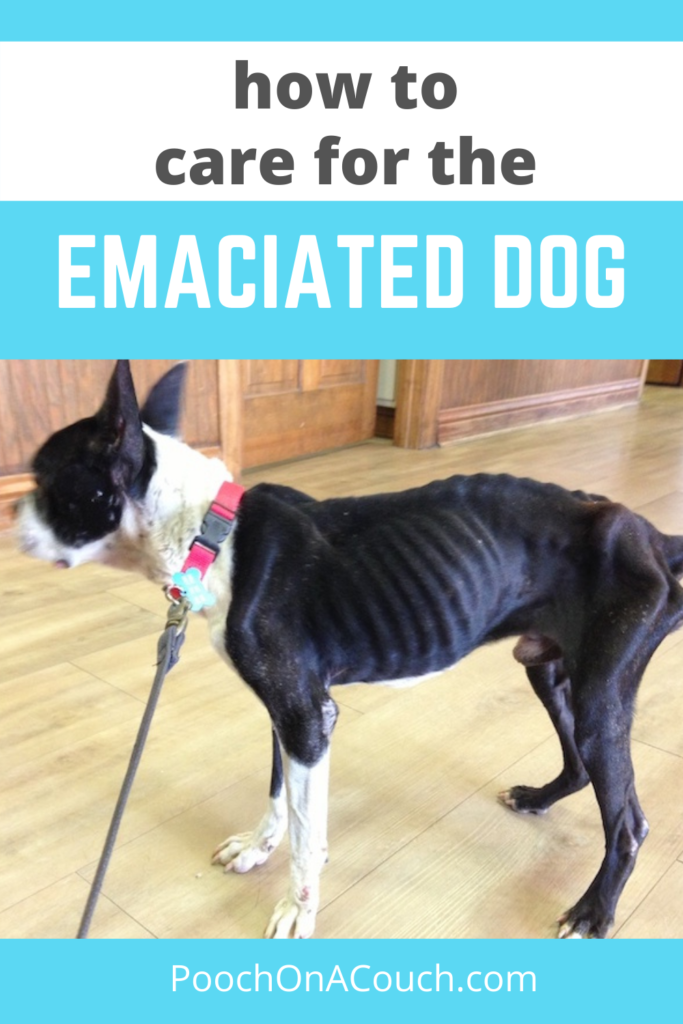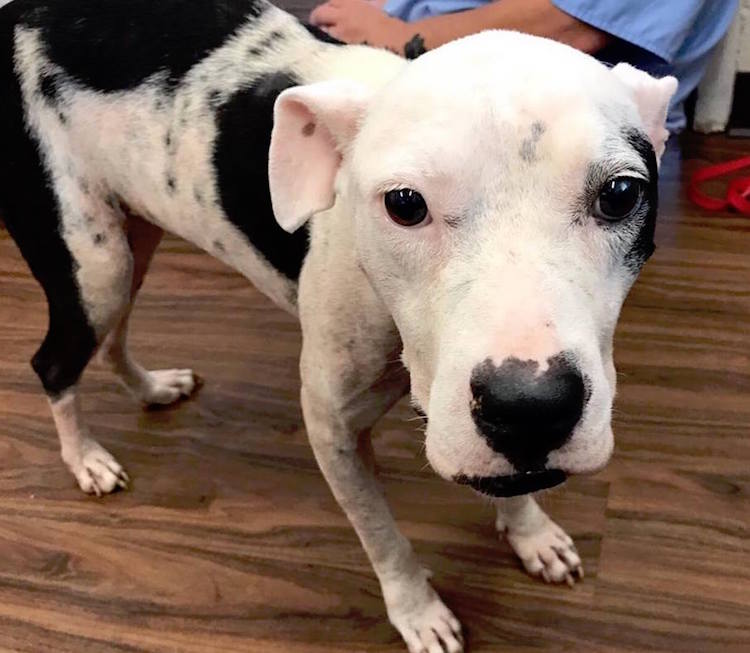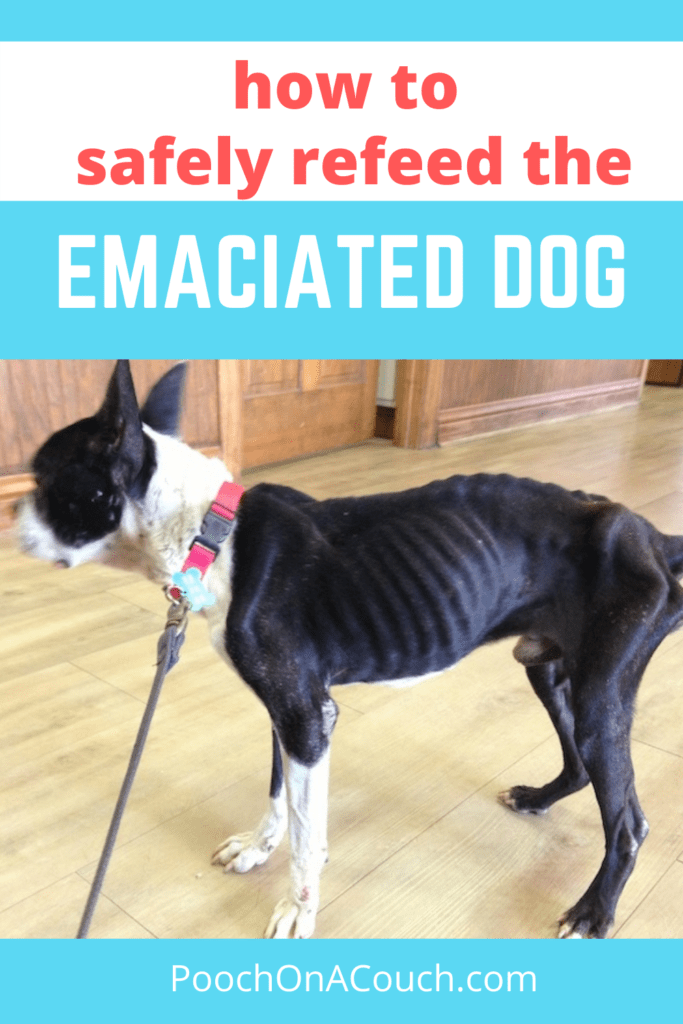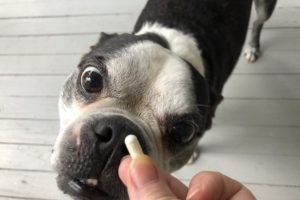If you are a rescuer or a foster home and you’ve never cared for an emaciated dog, you will at some point, and I want you prepared.
If you just found an emaciated dog and have found this blog post, PLEASE, get your dog to a veterinarian quickly.
I am not a veterinarian nor an animal behaviorist. I present my understanding of health or behavior issues based on personal experience and research I’ve done. If you have a dog with a health or behavioral issue, seek professional guidance. I hope you find my post useful.
This is a lengthy blog post, so I’m including my headings so you can scroll a bit easier if needed.
- Florence’s Story
- Chance’s Story
- Feast, Famine, and Cheeseburgers
- Starvation: More Than Just A Skinny Dog
- Re-Feeding A Starved Dog: What Could Go Wrong?
- When Does Refeeding Syndrome Happen?
- Saving an Emaciated Dog
- What To Expect From The Veterinarian
- The Formula For Refeeding And Why It’s Used
- The Long Road To Recovery
- Helpful Hints
- For Rescue Administrators
A Couple Of Stories
Florence – An Emaciated Dog
Rescued by animal control in Saraland, Alabama, Florence was found in horrible condition: At 29 pounds, she weighed half of what she should weigh. Her entire skeleton was visible under sagging skin. Lifting her lips revealed a hint into her current health: her gums were beyond pale, so gray they were nearly blue. The coat was missing big chunks of fur and her skin was red and inflamed from infection. She had deep, oozing anal sores. Florence would not live much longer without swift intervention. There would be nothing swift about her recovery.
Restoring health to an emaciated dog requires thoughtful assessment, a tempered refeeding plan, and patience. Lots of patience.
Chance, Another Emaciated Dog
As I was drafting this blog post, another set of horrific images came across my computer screen. A different dog, hours from dying. I knew of his rescuer, a woman who works hard to save the homeless and abandoned that cross her path. Her county of residence has no animal shelter, limited animal control services, and no funding.
Valerie Burnes graciously agreed to share Chance’s story and her work in saving his life.
“He was abandoned in an outdoor pen”, she recalls. He had no resources and no ability to hunt for his own food or water. He was trapped.
As she approached him, she could see the severity of muscle wasting. He struggled to stand and was unable to keep himself upright. “His body temperature was low, I knew he didn’t have long to live”. With no after-hours veterinarian available, Valerie took Chance home. They were on their own for the weekend.
Note: Going it alone is not advised for the inexperienced if you have any access to resources. Find a veterinarian or find a reputable rescue group that has access to veterinary care.
Chance had three urgent needs: warmth, the right amount of correct sustenance, and to be free of the million fleas that were no doubt contributing to his slow death.
Valerie made the difficult but correct decision – forgo the de-flea bath and keep him dry and warm. She picked fleas off of him for hours and fed him a liquid food, slightly warmed, to help keep his temperature up and rehydrate him.
Chance survived the next 36 hours and was hospitalized bright and early on Monday morning. He remained hospitalized for several days before being released to home care.
NEVER try and recover an emaciated dog without the guidance of a veterinarian. The content in this blog post is not intended for use in designing a refeeding plan for an emaciated dog. Only a veterinarian should provide treatment recommendations.
We want you to have a greater understanding of the effects of starvation, the risk of refeeding, and why a tempered refeeding plan is best. Please use your veterinarian’s guidance.
3. Feast, Famine, and Cheeseburgers
I began to read about the effects of starvation and am boggled at the complexity and in awe of the body’s ability to survive during starvation. The body systems are so intricate, so detailed, so interrelated and yet, so fragile.
So I turned to my friend and veterinarian Dr. Karen Ellis for a quick overview of canine nutrition, starvation, and what happens when a dog begins to eat again.
Feast/Famine and a dog’s tolerance for starvation
I asked Dr. Ellis rather bluntly, “Aren’t dogs built to handle starvation? I mean their ancestors would go days without eating and then feast on a kill. Feast/famine, right”?
“We hear that a lot, don’t we? Look, my poodle is as removed from wolves as I am from a Neanderthal. We cannot draw that conclusion”.
She went on to say, “First, wolves or wild dogs didn’t go days and days in between kills. They ate every couple of days. Second, when they did eat, they were eating a high protein, high fat diet. Finally, today’s domesticated dog is a different being with different mechanisms for survival. In many ways, they may not be as robust as their wild ancestors”.
In contrast, what we face when rescuing the emaciated dog is an animal that possibly hasn’t eaten anything in many days or has been slowly losing weight from illness or malnourishment.
There is much more to starvation than what we see on the outside. When we see an emaciated dog, we must assume the worst-case scenario and quickly seek veterinary care.
Cheeseburgers?
I met with Crystal Beatty, the Director for Saraland Animal Control and shelter, where Florence is receiving care. Crystal often encounters dogs in poor condition and she wants these emaciated dogs evaluated by a veterinarian prior to starting any refeeding plan.
“I don’t know how long they ‘ve been without resources, I don’t know if their organs are beginning to shut down”. Crystal emphasizes. So I asked her, half kidding, totally serious, “So you don’t order up a bag of cheeseburgers from the drive-thru”?
“Absolutely not”! she replied.
Florence’s plan? “Go slow. We are feeding Florence small meals, 3 small meals a day”.
Crystal also points out, “Just because a dog acts like it is starving doesn’t mean I should let it eat as much as possible. I won’t do it”.
While difficult, ignoring a dog’s ravenous behavior and pleading eyes is good medicine. Stick to a plan of strict calorie control and small, more frequent feedings. Free-feeding should never be done when beginning a refeeding plan.
The desire to generously feed a starving animal is human nature but can have disastrous consequences if done incautiously.
—-UC Davis Koret Shelter Medicine Program
Other Reasons to reconsider free-feeding when you are fostering dogs.
Starvation: More Than Just A Skinny Dog
I’m going to throw a bit of science at you, because caring for an emaciated dog requires some respect for science. Capisce?
Good. Here goes!
In a dog that has gone too long without eating, a complex set of changes occur, beginning in the second day a dog is without food. These progressive adaptations are how the body works to maintain homeostasis and fights to survive starvation, explains Dr. Ellis.
Not only do we see profound weight loss early on, but the body chemistry shifts, often dramatically, to preserve life. The metabolism slows down to reduce the amount of energy the body needs to maintain basic life functions.
All of the organ systems experience change, some more than others. Cardiac output slows – the heart rate slows and blood pressure drops. The heart can decrease in size. Hormone levels shift, the kidneys assume new roles. The body begins to make and use ketones as a source of energy to preserve protein reserves. Many changes are also occurring in the gut. Motility slows. Losses in the gut lead to impairment of the body’s immune system, increasing the dog’s susceptibility to illness or infections. [1]
That’s a lot to digest. No pun intended.
In a publication from UC Davis Koret Shelter Medicine Progam, the process of starvation is described in this way:
“During starvation, carbohydrate, fat, and protein stores are depleted in that order, preserving vital structural proteins as long as possible. Serum electrolyte balance is maintained by a shift of intracellular ions (potassium, phosphorus, and magnesium) to the extracellular space, leading to overall depletion of these electrolytes although serum values may be normal. (emphasis mine) Organ function is eventually comprised, leading to reduced cardiac, renal, immune and other functions”. [2]
Total electrolyte levels can be quite depleted even when on blood testing, the serum electrolytes are testing at normal levels.
As you can see, an emaciated dog is missing much more than just body weight!
ReFeeding A Starved Dog: What Could Go Wrong?
Because of the complex changes that occur during starvation, feeding an emaciated dog needs to be approached with caution and with the guidance of your veterinarian.
Electrolyte Imbalances
The primary complications from refeeding are often related to the depletion of electrolytes, particularly phosphorus. Dr. Ellis explains: “Normally low in a dog that eats well and regularly, these serum electrolyte levels can increase in a dog that is in starvation. When refeeding happens too quickly, the body isn’t prepared and these levels can drop very low, very fast”. When low phosphorus (called hypophosphatemia) occurs secondary to refeeding, it can be dramatic. [1] Low phosphorus can cause muscle weakness, anorexia, (refusal to eat) respiratory failure, heart failure, seizures, lethargy, and coma. Red blood cell rupture and hemolytic anemia are also possible with low phosphorus. [1] [2] As mentioned above, a starved dog that has begun to refeed can develop critically low electrolytes quickly. This can be life-threatening.
Dr. Ellis says, “carbohydrates seem to be the culprit”.
The consequence of hypophosphatemia can be severe and most of the clinical consequences associated with refeeding syndrome are attributed to low serum phospohorus. —–Nathan Peterson, DVM, DACVECC
Presented another way, “The mechanism varies, but in general when a starved animal is fed glucose or carbohydrates, these electrolytes are driven into the intracellular compartment, driving serum levels down”. [2]
Carbohydrates
When carbohydrates are a significant part of a diet used in refeeding, body abruptly stops fluid loss (which has been ongoing during starvation). The cessation of natriuresis can cause peripheral edema (swollen legs, for example) and fluid overload. This fluid retention places extra stress on an already compromised heart and heart failure can occur. [1]
Gastrointestinal Changes
As mentioned above, changes to the physiology and chemistry found in the gut affect how an emaciated dog is able to process and absorb nutrients going forward. Diarrhea is not uncommon and can complicate recovery by further depleting electrolyte reserves and increasing dehydration. “In day two without food, the gut cells begin to die”, says Dr. Ellis, making it harder for the gut to process food and absorb nutrients. In addition, certain cells in the lining of the gut aid the immune system. When these cells die off during starvation, the immune system is obviously compromised. In the case of Florence, her skin infections and deep sores could very well have been caused by her immune system not functioning to par.
These gastrointestinal issues also affect a dog’s appetite and may cause them to skip meals or seem finicky. Keeping a record of a dog’s intake at each meal every day is a really good idea.
If carbohydrates are reintroduced too quickly, the resulting fluid retention can overwhelm the patient’s limited cardiac reserve causing heart failure. —Ann Wortinger, BIS, LVT, VTS

When Does Refeeding Syndrome Happen?
Many of the articles I read said most refeeding complications show up 3-7 days after refeeding begins, but that it is possible for problems to surface early 24-72 hours after refeeding or delayed complications, around day 10. [1] [2] [3] It may not happen at all. Some experts consider refeeding syndrome a rarity in veterinary medicine, but I wonder how many dogs that succumb to complications from refeeding never arrive to the veterinarian for care.
Who Is At Risk?
If we accept the notion that we will not have any history on when the emaciated dog last at a meal or how long this dog has been slowly starved, the answer to that question is:
All emaciated dogs are at risk.
OK… How Skinny Is Too Skinny?
Veterinarians use a scale called the Body Condition Score to determine levels of lean muscle and fat. There are two different scales: One scale uses a 5-point measurement and the other uses a 9-point measurement.
UC Davis Koret Shelter Medicine Program most experts reference the 9- point scale and suggest that any dog that scores 3.5 points or lower out of 9 is at risk for refeeding complications. [1] [2] [3]
Saving The Life Of An Emaciated Dog
Seek immediate veterinary help.
It is the most important thing you can do for the life of the dog.
Starvation is a complicated process. Refeeding quickly and incorrectly can have great consequence.
It can also cost more later in veterinary bills. “Penny wise, pound foolish” I’ve been taught during my time in rescue. In truth, every time we thought to wait it out or take a short-cut, the dog needed more intervention at a higher cost. You need more money to provide emergency care? Ask your donors. They are your biggest fans and they want to help. Ask them.
Don’t rely on Google to get you through. Use the internet to supplement your knowledge about refeeding but allow your veterinarian to design an individual recovery plan tailored to the individual dog. Your outcomes will be better, I’m sure of it.
What To Expect From The Veterinarian
The Exam
Your veterinarian is most likely going to seek out three big pieces of information in order to best formulate a care plan for the emaciated dog. They will want to:
- Conduct a thorough wellness exam
- Assess the body condition score (BCS)
- Obtain a complete CBC/Chemistry profile and urinalysis. These lab tests look at everything – blood counts, electrolyte levels, glucose levels, organ function, and more. You really can’t assess the status of an emaciated dog without doing the lab work.
Other tests that are probably important to understanding the overall health of the dog:
The fecal test – now that we know about all the changes that occur in the gut during the process of starvation, it really makes sense to get a fecal test done as part of this first exam. We should know if there are internal parasites present in the emaciated dog. Internal parasites do their own damage to the gut and make processing nutrients that much harder. Yet, we don’t want to ask the system to do anything extra by adding deworming medication if it’s not needed.
Although not mentioned in the articles I read, a heartworm test couldn’t hurt – the heart is stress by prolonged starvation. Discovering the presence of heartworm might help your veterinarian further fine-tune the refeeding and treatment plan. Plus, sometimes you can bundle the heartworm test in with the CBC/Chemistry test which may be more cost-efficient. Just a thought.
The Plan
Is Hospitalization Required?
After completing the full exam and testings, the first decision your veterinarian will make is, Can this dog begin a refeeding plan at home or does this dog need hospitalization? Dogs with a very low BCS, dogs that are extremely anemic, weak, dehydrated or have electrolyte abnormalities may require hospitalization in order to stabilize.
Recovering the Dog At Home
When your veterinarian decides it is safe for your emaciated dog to recover at home, they will provide you with a very strict feeding plan.
The re-feeding plan will include:
- what diet to feed the dog
- how many times a day to feed the dog
- how much to feed at each meal.
- what (if any) supplements can be added (probiotics, vitamins, etc)
- other treatments (deworming medication, for example)
There will be instructions, too for what you cannot do.
- no sneaking extra food.
- no increasing daily calorie intake on your own. So, no extra teaspoon of wet food as tempting as that will be. I know it’s tempting for me.
- you will also probably have some guidelines on what kind of mobility your dog can have.
Expect for a dog with a BCS of 3 or less to need to be leashed walked until the BCS improves. Moving about is good; it helps restore motility and helps the bowels regulate.
The goal for the first week should be NO WEIGHT GAIN. [1]
The FORMULA For Refeeding The Starving Dog.
Math.
Yep. There’s math involved in refeeding. I’ll talk about the formula, and then, if you want to know more about why this formula yields such a shockingly low number of calories as a start off for your near-death-looking dog, you can read more about homeostasis, metabolic energy rates, and caloric need.
The Formula
The formula calculates the dog’s current caloric needs – not what the dog should need, but what they need right now.
The formula: kcals per day = 30(BW in kg) + 70
Ok – let’s do that math with Florence.
Florence weighed 29 pounds at rescue. That’s 13.15 kilograms.
30(13.15) + 70 = 465 calories per day.
Divided into 3 meals = 155 calories at each meal.
The vet may prescribe a diet called “Recovery” a high protein, high fat, nutrient rich food – so for these calculations, let’s use that diet’s nutritional panel to see how much food equals 155 calories.
[I’m using the “Recovery” diet for example only. Your veterinarian will discuss foods with you and make their recommendations based on the dog’s current status.]
This is a wet food – it comes in a 5.8 oz can, a little bit bigger than a can of tuna fish. Each of those cans holds 183 kcals of food. Or… there’s 31.5 calories in each ounce of food in that can. So, Florence might be prescribed 5 oz of the “Recovery” diet at each meal. Not even a whole can. That’s like a little more than half a cup, maybe?
I know what you are thinking. A dog that should weigh 60 pounds can’t gain weight on that little of food! A healthy 60 pound dog would need twice that amount of food or more to maintain weight! Wait. WHAT??
Here’s why: The dog’s energy needs have changed during the starvation process. It now needs less food. Remember how we said that the body continually made adjustments to it’s systems in order to survive starvation for as long as possible? One of the very first decisions the body makes is to stop requiring so much energy of itself, and it requires less and less as starvation continues. It’s a fascinating process.
What Does The Body Want? Homeostasis
Homeostasis is the body’s continuous goal – to maintain stability or equilibrium in order to sustain life. How our body regulates temperature is an example of homeostasis.
In terms of energy, the body’s goal is zero. In other words, at the end of the day, the body wants the amount of energy created (through the processing of nutrients) minus the amount of energy used (to exist, move about, produce) to equal zero.
In prolonged periods of starvation, the body continually changes its overall metabolism in order to hunker down, so to speak, and try and survive starvation for as long as possible. The metabolism can become quite low as the body works to slow down systems and spend as little energy as possible.
The body needs to need less energy to survive – it’s working to maintain homeostasis.
What Does The Body Need? Energy Requirements
The Basal Energy Rate (or Basal Metabolic Rate) is the amount of energy the body requires to simply stay alive. When the body is changing its processes in order to survive starvation, one of the body’s very first adjustments is the adjustment of how much energy the body uses to live. Not move about, not walk a mile, how much energy is required to exist. Live. The body quickly depletes its reserves and begins to slow down systems and prioritize organ functions to preserve energy reserves.
So, a starving, emaciated dog that just arrived in your care probably has a low basal energy rate. The dog is not using much energy and therefore, doesn’t need very many calories. As the body begins to slowly refeed and its systems return to normal function, the basal energy rate will improve, and daily caloric intake can safely increase.
Bottom line?
Before a dog can safely gain one pound of lean muscle mass, other measures of health have to be addressed, first. All of those amino acids, electrolytes, and other chemical thingys that are in the body that build new cells which build new tissue are all depleted. They must be restored, first. This can take a couple of weeks.
Early weight gain is most likely fluid retention, not lean muscle. And who wants fluid weight, right?
The Long Road To Recovery
Dr. Peterson points out that probably the biggest barrier to a dog’s recovery is caregiver compliance with a refeeding plan.
Dr. Ellis agrees. “We have to get used to seeing a skinny dog for a very long time”, she advises.
Perhaps the most difficult aspect of preventing and treating refeeding syndrome is convincing the owners/rescuers and hospital staff that a slow and methodical approach to refeeding is in the patient’s best interest. —Nathan Peterson, DVM, DACVECC
Helpful Hints to Stay On Course
Assign One Person As The Caregiver
Have one person in charge of feeding. Not only does it reduce the risk of error but it reduces the opportunity for a well-meaning person to over-feed or sneak a snack.
Keep A Journal
Keeping a journal or worksheets helps me when I’m caring for a dog with a restrictive treatment plan. I’m able to write down goals, daily actions, and my observations. I write down how man calories I fed at each meal and how much of that meal the dog consumed. Sometimes they don’t eat it all. I write that down, too. I bring my journal/notes with me to follow-up appointments in case the information is needed.
Photo journaling is a great idea, too.
When I feel sad while looking at my skinny foster and need some validation that what I’m doing is working, I can review my prior entries. I can see weight gain, calorie increases, improvements in body functions – data that confirms that the plan is working and the dog is improving. Even if they still look skinny as a rail.
Focus On The Numbers
Put your “blinders” on. Instead of looking at the dog’s appearance, look at the numbers. The blood work values are improving. The dog is getting to eat more calories each week. The weight is (yes, slowly!) increasing. The blood work values are improving. They are making progress. Safe progress. Steady progress. They will get there!
Be Patient
Crystal told me that Florence sometimes skips a meal or may eat only half a meal on occasion. “She’s a very slow eater! Picky, too”! This is not abnormal behavior for a dog that is recovering from starvation. Prolonged anorexia, though, requires a visit to the veterinarian.
The dog will gain weight on their own timeline. If they gain 2 pounds this week and only one pound the next, It’s OK. It does not mean the plan isn’t working. As the weeks progress, your veterinarian will give you the go-ahead to slowly add more and more calories. The weight will come back on!
Be Persistent
Crystal says sometimes starved dogs can be finicky eaters. Dr. T. J. Dunn, Jr, DVM, who writes for PetMD.com, agrees.
In the case of Florence, she was turning her nose away from most brands and flavors of dog food. Alarming, since Florence needed to consume nutrition if she was to survive. It was no time to dig in heels and insist that ‘if she’s hungry enough, she’ll eat!’ – “Florence didn’t have any reserves left”. Crystal said. “She needed to eat! And if there was only one brand and flavor of food that she would eat, we were going to make sure she got that food”. The community stepped up, and donations poured in.
“She needed to eat. If there was only one brand and flavor of food she would eat, we were going to make sure she got that food”. —-Crystal Beatty
Be Observant – Catch Refeeding Syndrome Early
Refeeding syndrome usually occurs within the first 3-7 days of the initiation of a refeeding plan, but it can occur in the first 24-48 hours after refeeding begins or even delay up to 10 days after you’ve started to refeed.
If serum electrolyte levels are checked frequently, refeeding syndrome can be caught early, possibly before the dog shows visible signs, but here are some symptoms to watch for:
- Fluid Retention – a part of the body looks puffy or swollen
- Anemia – gums look white or gray
- Urine color – turns dark or orange
- Diarrhea
- Restlessness
- Heart rate increases
- Vomiting
- Lethargy
- Seizures
- Confusion
If you see any of the above symptoms, the recommendation is to STOP FEEDING and immediately get your dog to the veterinarian.
For Rescue Administrators
I know how rescue world works – you or one of your volunteers will acquire an emaciated dog when it is off hours and there is no access to veterinary care. My article does not give recommendations on what to do when you can’t get that skinny dog to the vet. I’m not a veterinarian, and I cannot (will not) make treatment suggestions. Only your vet can do that, and I don’t want to get myself in any hot water!
What I want you to do is prepare for that scenario now by creating an emergency protocol.
If you truly don’t have an emergency veterinary service in your area, it may be reasonable to ask your vet to help you design a safe, interim protocol until you can access the veterinary clinic. The dog Chance is alive because of the relationship Valerie has with her veterinarian, and she knew what to do after hours. She was prepared, and she was at the vet with Chance first thing Monday morning.
If she’d fed him cheeseburgers all weekend, well – I don’t think he’d done as well.
I hope this helps increase awareness of the needs of emaciated dogs and helps you, the caregiver, make safe decisions when helping recover a dog that is in starvation.
In Summary and to recap:
- get the dog to the vet
- follow the plan, even when you feel like pushing ahead
- be observant.
- be patient.
References:
- Peterson, N. (2013). Refeeding Syndrome: How to Avoid, Recognize and Treat. Retrieved from https://www.vin.com
- Starvation And Re-Feeding Animals. (2010, July 9). Retrieved from https://www.sheltermedicine.com
- Wortinger, A. (2011). Refeeding Syndrome: When Good Food Goes Bad. Retrieved from https://wendyblount.com/taca4/Refeeding.pdf
For More Information About Starvation and Re-Feeding:
Starvation And Re-Feeding Animals
Caring For A Starved Emaciated Dog
Feeding Skinny Dogs: Helpful or Harmful?
Popular Posts
- HOW TO CHOOSE A DOG RESCUE AGENCY
- ULTIMATE GUIDE TO FOSTERING: 10 SKILLS YOU NEED
- VOLUNTEER IF YOU CANNOT FOSTER





